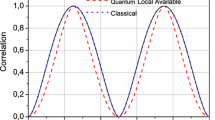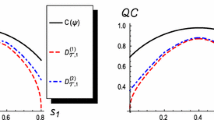Abstract
In a bipartite quantum system, quantum states are classified as classically correlated (CC) and quantum correlated (QC) states, the later are important resources of quantum information and computation protocols. Since correlations of quantum states may vary under a quantum channel, it is necessary to explore the influence of quantum channels on correlations of quantum states. In this paper, we discuss CC-preserving, QC-breaking and strongly CC-preserving local quantum channels of the form \(\Phi _1\otimes \Phi _2\) and obtain the structures of these three types of local quantum channels. Moreover, we obtain a necessary and sufficient condition for a quantum state to be transformed into a CC state by a specific local channel \(\Phi _1\otimes \Phi _2\) in terms of the structure of the input quantum state. Lastly, as applications of the obtained results, we present a classification of local quantum channels \(\Phi _1\otimes \Phi _2\) and describe the quantum states which are transformed as CC ones by the corresponding local quantum channel.
Similar content being viewed by others
References
Luo, S.L.: Using measurement-induced disturbance to characterize correlations as classical or quantum. Phys. Rev. A 77, 022301 (2008)
Dagomir, K., Aditi, S., Ujjwal, S., Vlatko, V., Andreas, W.: Quantum correlation without classical correlations. Phys. Rev. Lett. 101, 070502 (2008)
Luo, S.L.: Quantum discord for two-qubit systems. Phys. Rev. A 77, 042303 (2008)
Piani, M., Horodecki, P., Horodecki, R.: No-local-broadcasting theorem for multipartite quantum correlations. Phys. Rev. Lett. 100, 090502 (2008)
Ferraro, A., Aolita, L., Cavalcanti, D., Cucchietti, F.M., Acin, A.: Almost all quantum states have nonclassical correlations. Phys. Rev. A 81, 052318 (2010)
Aharon, B., Kavan, M.: Criteria for measures of quantum correlations. Quantum. Inf. Comput. 12, 721–742 (2011)
Guo, Z.H., Cao, H.X., Chen, Z.L.: Distinguishing classical correlations from quantum correlations. J. Phys. A: Math. Theor. 45, 145301 (2012)
Wu, Y.C., Guo, G.C.: Norm-based measurement of quantum correlation. Phys. Rev. A 83, 062301 (2011)
Zhou, T., Cui, J.X., Long, G.L.: Measure of nonclassical correlation in coherence- vector representation. Phys. Rev. A 84, 062105 (2011)
Guo, Z.H., Cao, H.X.: A classification of correlations of tripartite mixed states. Int. J. Theor. Phys. 52, 1768–1779 (2013)
Guo, Z.H., Cao, H.X., Qu, S.X.: Partial correlations in multipartite quantum systems. Information Sciences 289, 262–272 (2014)
Streltsov, A., Kampermann, H., Bruß, D.: Behavior of quantum correlations under local noise. Phys. Rev. Lett. 107, 170502 (2011)
Gessner, M., Laine, E., Breuer, H., Piilo, J.: Correlations in quantum states and the local creation of quantum discord. Phys. Rev. A 85, 052122 (2012)
Hu, X.M., Fan, H., Zhou, D.L., Liu, W.M.: Necessary and sufficient conditions for local creation of quantum correlation. Phys. Rev. A 85, 032102 (2012)
Guo, Y., Hou, J.C.: Necessary and sufficient conditions for the local creation of quantum discord. J. Phys. A: Math. Theor. 46, 155301 (2013)
Guo, Z.H., Cao, H.X.: Local quantum channels preserving classical correlations. J. Phys. A: Math. Theor. 46, 065303 (2013)
Korbicz, J.K., Horodecki, P., Horodecki, R.: Quantum-correlation breaking channels, broadcasting scenarios, and finite Markov chains. Phys. Rev. A 86, 042319 (2012)
Horodecki, M., Shor, P.W., Ruskai, M.B.: Entanglement breaking channels. Rev. Math. Phys. 15, 629 (2003)
Moravcíková, L., Ziman, M.: Entanglement-annihilating and entanglement-breaking channels. J. Phys. A: Math. Theor. 43, 275306 (2010)
Acknowledgments
The authors would like to thank the referee for his/her kind comments and valuable suggestions. This research was partially supported by the National Natural Science Foundation of China (11401359, 11371012, 11301318, 11471200), China Postdoctoral Science Foundation (2014M552405), the Natural Science Research Program of Shaanxi Province (2014JQ1010) and Postdoctoral Science Foundation of Shaanxi Province.
Author information
Authors and Affiliations
Corresponding author
Appendix: Proofs of Lemmas
Appendix: Proofs of Lemmas
Proof of Lemma 2.3 \((1)\Rightarrow (2):\) Suppose that \(\Phi (\mathcal {M}_n)\) is commutative, then the operators in \(\Phi (\mathcal {M}_n)\) are all normal and pairwise commute. Assume that \(\Phi (\mathcal {M}_n)=\text{ span }\{A_1,A_2,\ldots ,A_m\},\ m=\dim (\Phi (\mathcal {M}_n)),\) where \([A_i,A_j]=0\) for \(i\ne j\), then there exists an orthonormal basis \(\{|k\rangle \}_{k=1}^n\) for \(\mathbb {C}^n\) such that \(A_j=\sum _{k=1}^n \lambda _{kj}|k\rangle \langle k|\) for all \(j=1,2,\ldots ,m\). For any \(A\in \mathcal {M}_n\), there exists a unique sequence \(\{c_j(A)\}_{j=1}^m\) of complex numbers such that
where \(f_k(A)=\sum _{j=1}^mc_j(A)\lambda _{kj}\) for all \(k\). Clearly, \(f_k(A)=\langle k|\Phi (A)|k\rangle =\text{ tr }(\Phi ^\dag (|k\rangle \langle k|)A)\), where \(\Phi ^\dag \) denotes the dual map of \(\Phi \) with respect to the Hilbert-Schmidt inner product on \(\mathcal {M}_n\). Thus,
It is easy to see that \(\{\Phi ^\dag (|k\rangle \langle k|)\}\) is a POVM for \({\mathbb {C}}^n\). This shows that \(\Phi \) is a measurement map.
\((2)\Rightarrow (1)\) and \((1)\Rightarrow (3)\): Evidently.
\((3)\Rightarrow (1):\) Let (3) hold. Then \([\Phi (\sigma _1), \Phi (\sigma _2)]=0\) for all positive operators \(\sigma _1,\sigma _2\) on \({\mathbb {C}}^n\). By using the spectral theorem we see that \([\Phi (\sigma _1), \Phi (\sigma _2)]=0\) for all Hermitian operators \(\sigma _1,\sigma _2\) on \({\mathbb {C}}^n\). So, \([\Phi (\sigma _1), \Phi (\sigma _2)]=0\) for all operators \(\sigma _1,\sigma _2\) on \({\mathbb {C}}^n\). \(\square \)
Proof of Lemma 4.1
To show this, without loss of generality, we may assume that \(\Phi (A) = tUAU^\dag + \frac{1-t}{n}\text{ tr }(A)I_n\) for all \(A\in \mathcal {M}_n\) where \(U\) is a unitary matrix, \(-\frac{1}{n-1}\le t\le 1\) and \(t\ne 0\). Clearly, for any \(Y\in \mathcal {M}_n\), the matrix \(X=\frac{1}{t}(U^\dag YU-\frac{1-t}{n}\text{ tr }(Y)I_n)\) satisfies \(\Phi (X)=Y\). This implies that \(\Phi \) is surjective. On the other hand, let \(\Phi (A)=\Phi (B)\), that is, \(tU(A-B)U^\dag +\frac{1-t}{n}\text{ tr }(A-B)I_n=0.\) Then we have \(A-B=\frac{t-1}{tn}\text{ tr }(A-B)I_n\) since \(t\ne 0\). Now we take trace operation and get that \((t-1)\text{ tr }(A-B)=t\cdot \text{ tr }(A-B)\). This shows that \(\text{ tr }(A-B)=0\) and thus \(\text{ tr }(A)=\text{ tr }(B)\). Since \(\Phi (A)=\Phi (B)\), we get that \(tUAU^\dag =tUBU^\dag \) and so \(A=B\). Hence, \(\Phi \) is injective. \(\square \)
Proof of Lemma 4.2
The “if part” is clear. We only need to prove the “only if part”. Let \(\sum _{i=1}^k X_i\otimes Y_i=0\). Then for any pure states \(|c\rangle , |d\rangle \in \mathbb {C}^m\) we have
Since \(\{X_i\}_{i=1}^{k}\) is a linearly independent family, \(\langle c|Y_i|d\rangle =0\) for all \(i\) and all \(|c\rangle , |d\rangle \in \mathbb {C}^m\). That is, \(Y_i=0\) for all \(i\in \{1,2,\ldots , k\}.\) \(\square \)
Proof of Lemma 4.3
For any \(\rho =\sum _iA_i\otimes B_i\), there exist \(C_i, D_i\) such that \(\Phi _1(C_i)=A_i\) and \(\Phi _2(D_i)=B_i\) for all \(i\). Put \(\sigma =\sum _iC_i\otimes D_i\), then \((\Phi _1\otimes \Phi _2)(\sigma )=\rho \) and thus \(\Phi _1\otimes \Phi _2\) is surjective. On the other hand, for any \(\sigma _1,\sigma _2\) in \(\mathcal {M}_n\otimes \mathcal {M}_m\), we write \(\sigma _1=\sum _{i,j}E_{ij}\otimes A_{ij}, \sigma _2=\sum _{i,j}E_{ij}\otimes B_{ij},\) where \(E_{ij}=|i\rangle \langle j|\) and \(\{|i\rangle \}\) is an orthonormal basis for \({\mathbb {C}}^n\). Suppose that \((\Phi _1\otimes \Phi _2)(\sigma _1)=(\Phi _1\otimes \Phi _2)(\sigma _2)\), then
Since \(\{E_{ij}\}\) is a Hamel basis for \(\mathcal {M}_n\) and \(\Phi _1\) is a linear isomorphism, \(\{\Phi _1(E_{ij})\}\) is a linearly independent set. By Lemma 4.2, we have \(\Phi _2(A_{ij})-\Phi _2(B_{ij})=0\) for all \(i,j\), so \(A_{ij}=B_{ij}\) for all \(i,j\) since \(\Phi _2\) is also a bijection. Therefore, \(\sigma _1=\sigma _2\). Thus, \(\Phi _1\otimes \Phi _2\) is a linear bijection. \(\square \)
Proof of Lemma 4.4
Necessity Suppose that \(\Phi _1\otimes \Phi _2\) is strongly CC-preserving. Then \(\Phi _1\) and \(\Phi _2\) are commutativity preserving on states and then commutativity preserving. Assume that \(\Phi _2\) is not commutativity preserving in both directions. Then there exist \(\rho _2,\sigma _2\in \mathcal {D}({\mathbb {C}}^m)\) such that \([\rho _2,\sigma _2]\ne 0\) but \([\Phi _2(\rho _2),\Phi _2(\sigma _2)]=0\). Choose \(\rho _1,\sigma _1\in \mathcal {D}({\mathbb {C}}^n)\) such that \(\rho _1\ne \sigma _1\) and \([\rho _1,\sigma _1]=0\), and let \(\rho =\frac{1}{2}\rho _1\otimes \rho _2+\frac{1}{2}\sigma _1\otimes \sigma _2.\) Then \(\rho \) is not a CC state (Lemma 3.1) and
Since \([\Phi _1(\rho _1),\Phi _1(\sigma _1)]=0\) and \([\Phi _2(\rho _2),\Phi _2(\sigma _2)]=0\), it follows from Lemma 3.1 that \((\Phi _1\otimes \Phi _2)(\rho )\) is a CC state, while \(\rho \) is not a CC state, a contradiction. Thus, \(\Phi _2\) is commutativity preserving in both directions. Similarly, one can show that \(\Phi _1\) is commutativity preserving in both directions.
Sufficiency. Suppose that \(\Phi _1\) and \(\Phi _2\) are commutativity preserving in both directions. First, let us check that both \(\Phi _1\) and \(\Phi _2\) are bijective. To do this, we assume that \(\Phi _1(X)=0\). Then \([\Phi _1(X),\Phi _1(A)]=0\) for all \(A\in \mathcal {M}_n\). Since \(\Phi _1\) is commutativity preserving in both directions, we conclude that \(X=cI_n\). Because that \(\Phi _1\) is trace-preserving, we see that \(c=0\) and then \(X=0\). This shows that \(\Phi _1\) is injective and so bijective since \(\dim {\mathcal {M}_n}=n^2<\infty \). Similarly, \(\Phi _2\) is bijective. Let \(\rho \in CC({\mathbb {C}}^n\otimes {\mathbb {C}}^m)\). Then by using Lemma 3.2, we can find two commuting families of normal operators \(\{C_i\}\) and \(\{D_i\}\) such that \(\rho =\sum _iC_i\otimes D_i\). Thus, \((\Phi _1\otimes \Phi _2)(\rho )=\sum _i\Phi _1(C_i)\otimes \Phi _2(D_i)\). Since \(\Phi _1\) and \(\Phi _2\) are commutativity preserving and \(\dag \)-preserving, we see that \(\{\Phi _1(C_i)\}\) and \(\{\Phi _2(D_i)\}\) are commuting families of normal operators. By using Lemma 3.2 again, we conclude that \((\Phi _1\otimes \Phi _2)(\rho )\) is a CC state. Let \(\rho \in \mathcal {D}({\mathbb {C}}^n\otimes {\mathbb {C}}^m)\) and \((\Phi _1\otimes \Phi _2)(\rho )\) be a CC state. It follows from Lemma 3.2 that \((\Phi _1\otimes \Phi _2)(\rho )=\sum _iA_i\otimes B_i\) for some commuting families \(\{A_i\}\) and \(\{B_i\}\) of normal operators. Since \(\Phi _1\) and \(\Phi _2\) are bijective (Lemma 4.1) and commutativity preserving in both directions, we can find two commuting families of normal operators \(\{C_i\}\) and \(\{D_i\}\) such that \(\Phi _1(C_i)=A_i\) and \(\Phi _2(D_i)=B_i\) for all \(i\). Therefore, \((\Phi _1\otimes \Phi _2)(\sum _iC_i\otimes D_i)=\sum _iA_i\otimes B_i\) and thus \(\rho =\sum _iC_i\otimes D_i\) since \(\Phi _1\otimes \Phi _2\) are injective. Hence, \(\rho \in CC({\mathbb {C}}^n\otimes {\mathbb {C}}^m)\) (Lemma 3.2). Thus, \(\Phi _1\otimes \Phi _2\) is strongly CC-preserving. \(\square \)
Rights and permissions
About this article
Cite this article
Guo, Z., Cao, H. & Qu, S. Structures of Three Types of Local Quantum Channels Based on Quantum Correlations. Found Phys 45, 355–369 (2015). https://doi.org/10.1007/s10701-015-9874-9
Received:
Accepted:
Published:
Issue Date:
DOI: https://doi.org/10.1007/s10701-015-9874-9




